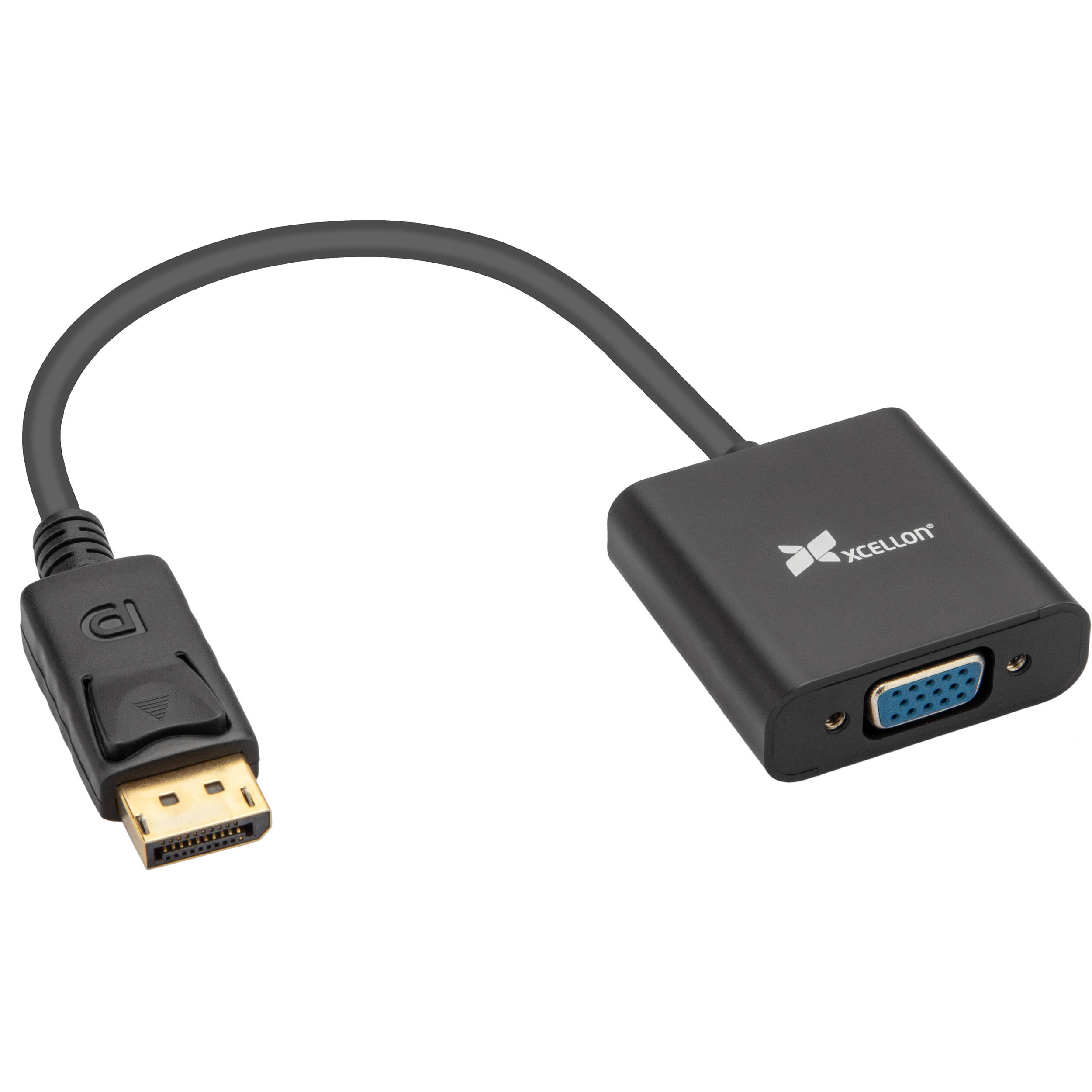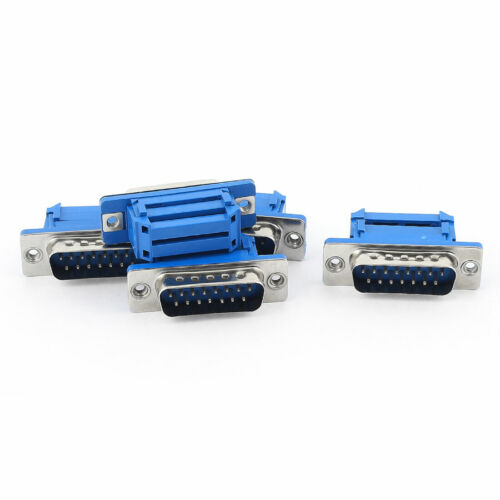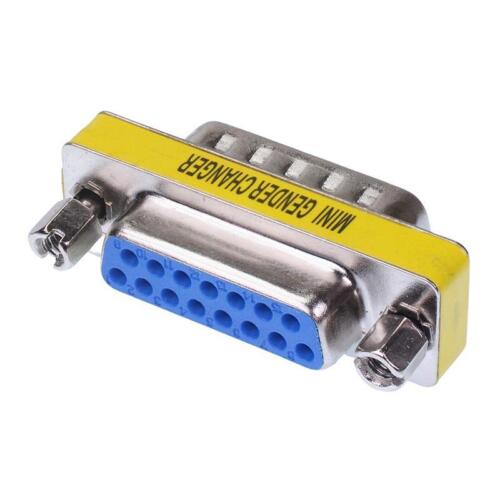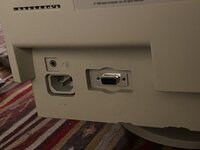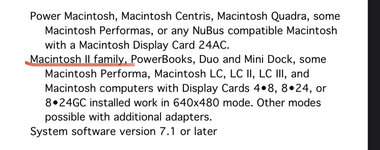bigmessowires
Well-known member
There's also a mechanical design problem here, independent of the whole sync splitting business. I noticed this at Mactoberfest when I plugged the prototype adapter into a bunch of different Macs: it's a tight fit on some Macs with a slotted video card, and I'm afraid the solder bumps on the bottom of the adapter PCB may short out against the metal frame surrounding the monitor connector on those Macs.
Compared to the Griffin Mac PnP adapter, my adapter has about 3mm more material below the DB-15 Mac connector, and that begins to cause clearance problems for some video cards. Here are the two adapters resting on the desk, with the DB-15s facing each other. Notice how the BMOW adapter sits a few millimeters higher.
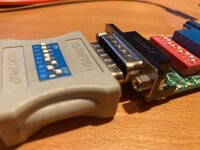
Here are the adapters lying on their side edges, with the two DB-15s approximately aligned. This gives you a better idea of where the extra thickness is coming from in the BMOW adapter.
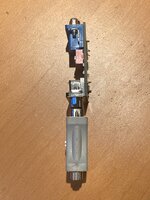
The Griffin adapter probably uses a DB-15 with in-line solder cup terminals that come straight out the back, and it's secured inside a custom injection molded case. But my adapter uses a right-angle DB-15, so there's a 1.6 mm thick PCB below the DB-15, and then pins stick out roughly an additional 1.5mm below that.
There isn't a whole lot that I could do to improve this. I can use a 1.2mm thick PCB instead of the standard 1.6mm, which might help a little, but the pins will still stick out just as far as before. I could cut the pins flush with a side cutter, which is OK for a one-off, but I don't think it's possible to batch assemble larger numbers of units that way.
If I switched to a DB-15 with solder cup terminals, there's no great way to attach it to the PCB. The best option would be to sandwich the PCB between the two rows of solder cups, which is exactly what I do with the DB-19 on the Floppy Emu adapter:
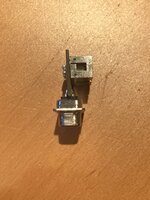
This is a little funky, since the exact distance between rows of solder cups is not standardized. A 1.6 mm PCB usually fits but is super tight, while a 1.2 mm PCB is loose and needs to be secured somehow until it's soldered down. Manufacturers don't like this method very much since it's non-standard. I think it needs to be assembled by hand.
I couldn't use the same PCB sandwich technique on the VGA connector side, since it has 3 rows of terminals instead of 2. I'd have to continue using a right angle connector like I already have now. That's not a problem for fit since the VGA connector is far enough away from the body of the Mac, but it means the DB-15 and the VGA connector wouldn't be in the same plane, and the adapter would look a bit odd. I think the DB-15 with solder cups is also slightly longer front-to-back than the DB-15 right angle, so the whole adapter would need to be a few mm longer.
If there were a DB-15 right angle surface mount part, that might help things. But I don't think that exists.
Any brilliant suggestions? The current design may actually be good enough as-is, even if it's a tight fit on some. I didn't have enough time at Mactoberfest to really pay attention carefully to the fit, or see how close the solder bumps got to any metal frame pieces. For Macs with built-in video like the IIci where the connector is horizontal, there's no fit problem at all. I think it's only a potential issue when the connector is vertical, such as when you're using a NuBus or PCI video card.
Compared to the Griffin Mac PnP adapter, my adapter has about 3mm more material below the DB-15 Mac connector, and that begins to cause clearance problems for some video cards. Here are the two adapters resting on the desk, with the DB-15s facing each other. Notice how the BMOW adapter sits a few millimeters higher.

Here are the adapters lying on their side edges, with the two DB-15s approximately aligned. This gives you a better idea of where the extra thickness is coming from in the BMOW adapter.

The Griffin adapter probably uses a DB-15 with in-line solder cup terminals that come straight out the back, and it's secured inside a custom injection molded case. But my adapter uses a right-angle DB-15, so there's a 1.6 mm thick PCB below the DB-15, and then pins stick out roughly an additional 1.5mm below that.
There isn't a whole lot that I could do to improve this. I can use a 1.2mm thick PCB instead of the standard 1.6mm, which might help a little, but the pins will still stick out just as far as before. I could cut the pins flush with a side cutter, which is OK for a one-off, but I don't think it's possible to batch assemble larger numbers of units that way.
If I switched to a DB-15 with solder cup terminals, there's no great way to attach it to the PCB. The best option would be to sandwich the PCB between the two rows of solder cups, which is exactly what I do with the DB-19 on the Floppy Emu adapter:

This is a little funky, since the exact distance between rows of solder cups is not standardized. A 1.6 mm PCB usually fits but is super tight, while a 1.2 mm PCB is loose and needs to be secured somehow until it's soldered down. Manufacturers don't like this method very much since it's non-standard. I think it needs to be assembled by hand.
I couldn't use the same PCB sandwich technique on the VGA connector side, since it has 3 rows of terminals instead of 2. I'd have to continue using a right angle connector like I already have now. That's not a problem for fit since the VGA connector is far enough away from the body of the Mac, but it means the DB-15 and the VGA connector wouldn't be in the same plane, and the adapter would look a bit odd. I think the DB-15 with solder cups is also slightly longer front-to-back than the DB-15 right angle, so the whole adapter would need to be a few mm longer.
If there were a DB-15 right angle surface mount part, that might help things. But I don't think that exists.
Any brilliant suggestions? The current design may actually be good enough as-is, even if it's a tight fit on some. I didn't have enough time at Mactoberfest to really pay attention carefully to the fit, or see how close the solder bumps got to any metal frame pieces. For Macs with built-in video like the IIci where the connector is horizontal, there's no fit problem at all. I think it's only a potential issue when the connector is vertical, such as when you're using a NuBus or PCI video card.

